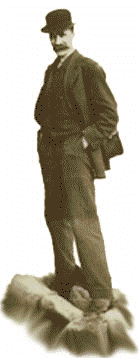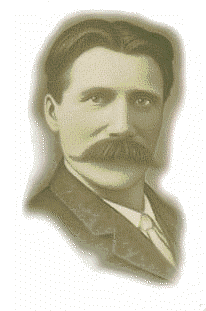Biography of 
Jacob
"Simy" Simonson
Jacob Simonson's death made front page
news in April of 1947, but now very little is known of this
"recorder of an epic era" (Prince George Citizen, April
10, 1947, Front Page). Much of what we know leads to more
questions. We know he was born in Norway in 1866 and he arrived
in South Fort George in 1910. We know that he was a widower and a
Canadian citizen at the time of his death yet nothing is known
about his wife, other family, or when and why he became a
citizen. One pioneer in the community remembers Simy as a cat
lover and a member of the Jehovah Witness faith, while another
recalls him sometimes going by the name of John. Simonson's
studio was located in South Fort George probably on 2nd Street,
which is now known as Hazelton Avenue. It is also believed that
he lived in the area behind his studio. The studio was unique in
that there was a large piece of glass in the northern part of the
roof which provided him with natural light.
 Simonson died on April 4, 1947 at Prince George
Regional Hospital and was buried in an unmarked grave at the
Prince George Cemetery. Even the location of his final resting
place was lost for a time because of a clerical error in the
spelling of Simy's last name in the files of the Prince George
Cemetery that was not discovered until recently.
Simonson died on April 4, 1947 at Prince George
Regional Hospital and was buried in an unmarked grave at the
Prince George Cemetery. Even the location of his final resting
place was lost for a time because of a clerical error in the
spelling of Simy's last name in the files of the Prince George
Cemetery that was not discovered until recently.
Simonson's photos are part of the Wally West Collection acquired
by the Fraser-Fort George Regional Museum in 1993, and consist of 230 images and
120 glass plate negatives. Dated between 1910-1925, these photos
are the single most significant collection of the early
settlement days of this area. Many of his images capture
important "firsts", such as the first sternwheeler, the first stage coach, and the first
Fall Fair, later known as the Prince George Exhibition. Overall,
Simonson's images illustrate his attachment to the land as well
as to the lives of the early settlers, each photo suggesting a
story about it's subject. The majority of the images focus more
on local surroundings or events rather than on specific people.
The collection is rich in street scenes, nature scenes and scenes
of early construction and industry or community events with only
a few portraits.
The investigation into Simonson's life
and the search for more of his images continues. Dave Mattison, a
historian at the Provincial Archives, is compiling a directory of early
photographers. Although Simonson is listed, there is no record of
any collections of his work other that the one housed in the
Fraser-Fort George Regional Museum. The library at the University of British Columbia only has two Simonson images in it's
extensive collection. However, since he was considered a
"master photographer" by his peers at the time of his
death, and since he lived in the area for 34 years, it seems
logical that there are more Simonson images and aquaintances in
our community.
His obituary, written fifty years ago,
seems to warn of his disappearance from historical record.
"[Simonson's] passing is another blow to...hopes that at
some time an historical society might obtain possession
of...photographs and documents of an era slipping from their
grasp." (Prince George Citizen, April 10, 1947, Page 12).


 Simonson died on April 4, 1947 at Prince George
Regional Hospital and was buried in an unmarked grave at the
Prince George Cemetery. Even the location of his final resting
place was lost for a time because of a clerical error in the
spelling of Simy's last name in the files of the Prince George
Cemetery that was not discovered until recently.
Simonson died on April 4, 1947 at Prince George
Regional Hospital and was buried in an unmarked grave at the
Prince George Cemetery. Even the location of his final resting
place was lost for a time because of a clerical error in the
spelling of Simy's last name in the files of the Prince George
Cemetery that was not discovered until recently.